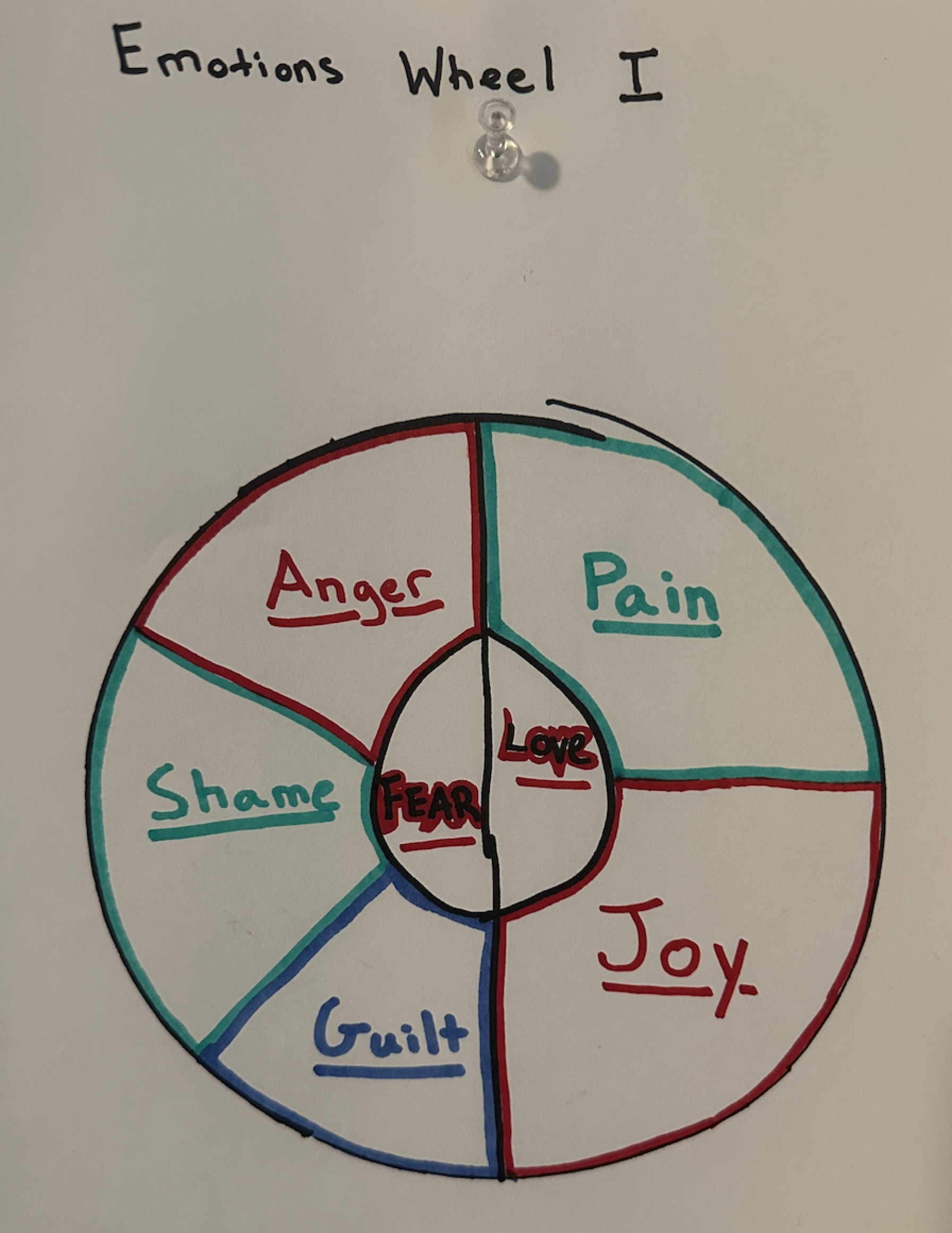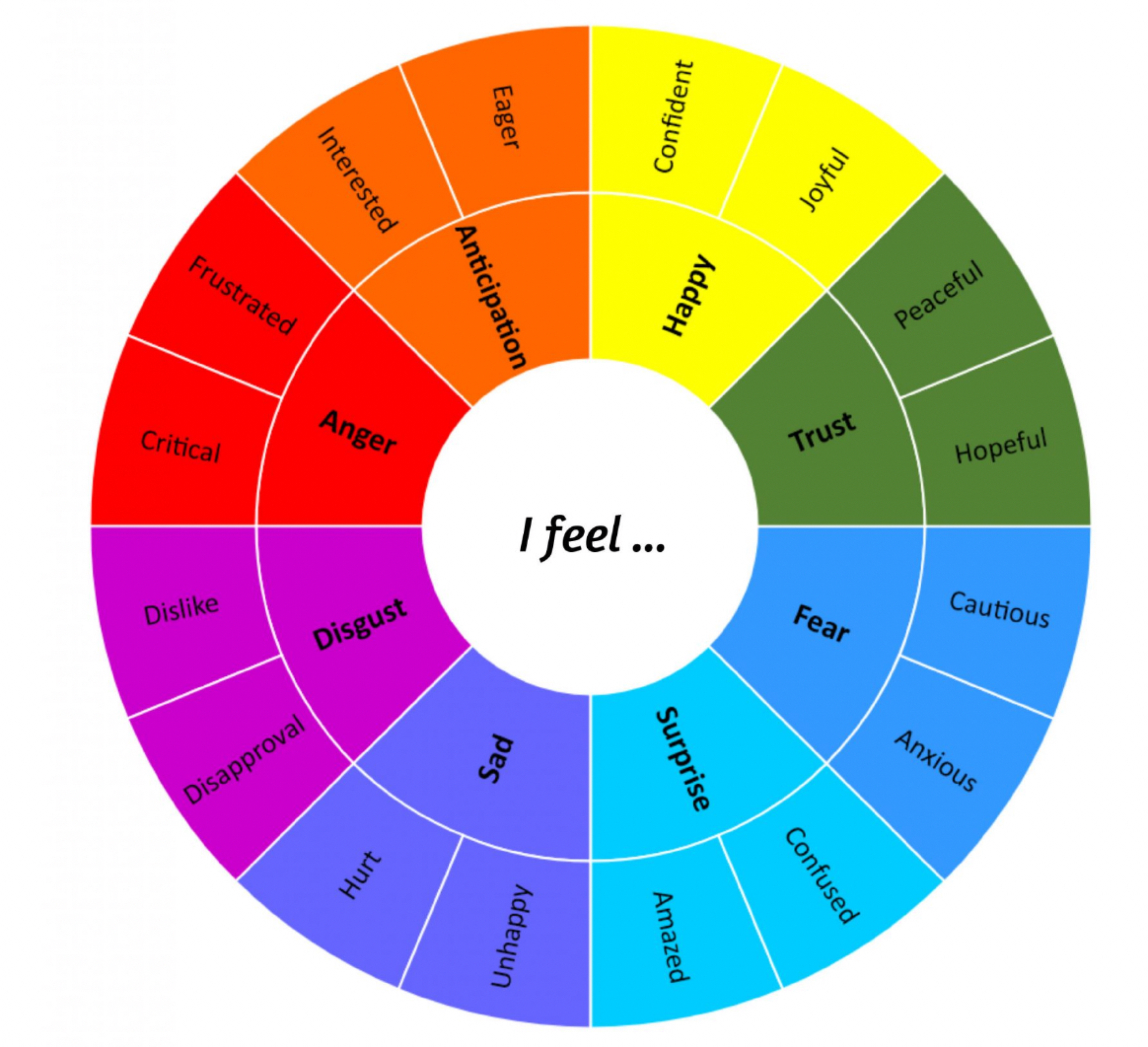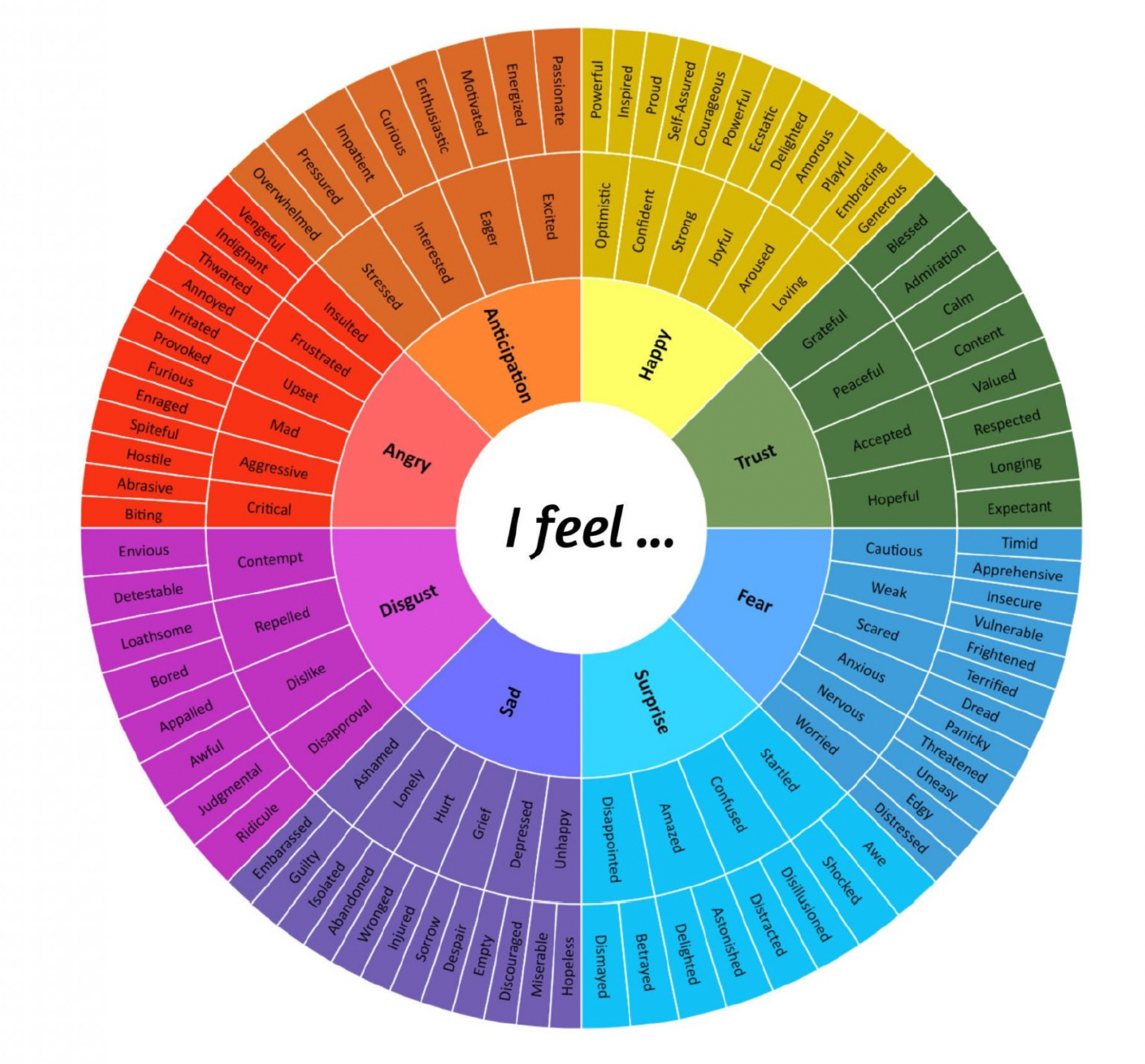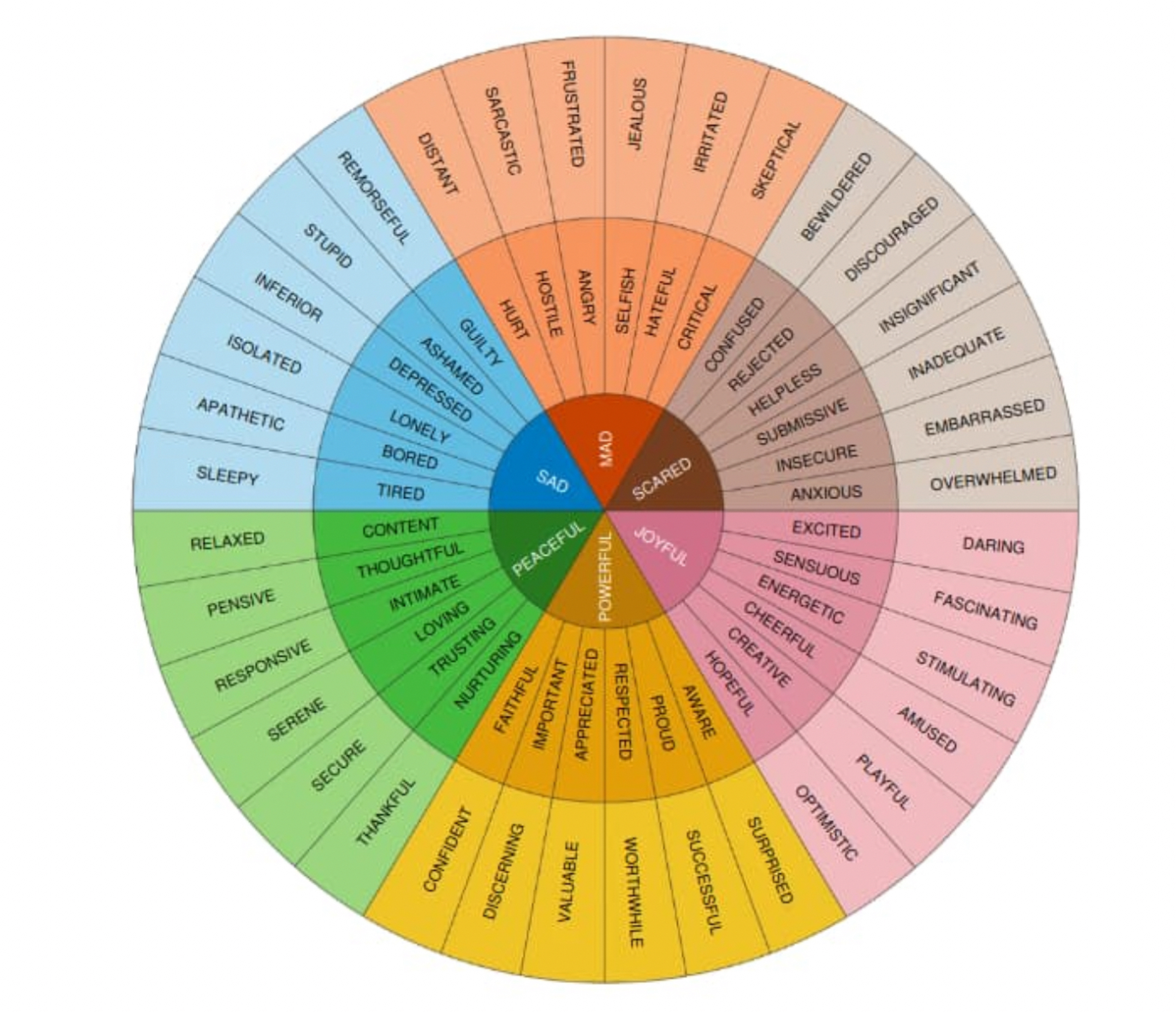
One of the most important tools I've found helpful in developing my understanding around emotions has been the emotions wheel.
There are many of them online that you can find and use to look at to better label and identify what you are experiencing. When we are in the moment it can be difficult to bring to mind the range of different emotions and this wheel with all the emotions listed can be a critical tool for processing.
Dr. Paul Ekman has theorized that there are 7 universal emotions, however the science on emotions is always growing and changing. Dr. Brene Brown mentions in her book the importance of emotional nuance which is why she decided to take a broad approach to looking at the different ones listed in her book.
You can look at her full list of emotions here on her website.
I started this blog post with my first emotions wheel that I created for myself as it is a basic one that is less intimidating than looking at one with dozens or even a hundred different emotions listed. As you get more familiar with the different emotions listed you can grow to using a more expansive wheel.

Places We Go When It's Beyond Us
Awe and Wonder
Wonder and Awe are often used interchangeably as they are pretty similar but the research shows that:
"Wonder inspires the wish to understand; awe inspires the wish to let shine, to acknolwedge and to unite."
When we feeling awe, we tend to simply stand back and observe, to provide a stage for the phenomenon to shine.
Wonder fuels our passion for exploration and learning for curiosity and adventure.
Awe-inducing events may be one of the fastest and most powerful methods of personal change and growth.
Curiosity and Interest
Curiosity seems to be both a trait and a state. You can be a curious person and, regardless of having this trait or not, you can feel curious about something in the moment.
Interest is more of a state ("interested" is not who we are but how we are at a specific time).
With interest, our mind is open to seeing what's there, but with curiosity, we've acknowledged a gap in what we know or understand, and our heart and head are both invested in closing that gap.
Curiosity is the feeling of deprivation we experience when we identify and focus on a gap in our knowledge. Choosing to be curious is choosing to be vulnerable because it requires us to surrender to uncertainty.

Places We Go When Things Aren't What They Seem
Brene opens this chapter with two really great questions.
What happens when we feel two competing emotions at the same time?"
Can two seemingly contradictory thoughts both be true?
Welcome to being human! :)
Bittersweet
It was helpful to learn that bittersweet is a mixed feeling of happiness and sadness.
Developmental milestones tend to leave us feeling bittersweet.
Sadness about letting go of something, mixed with happiness and/or gratitude about what's been experienced and/or what's next.
It's also possible that feeling bittersweet may be more frequently experienced or recognized by people who have a more nuanced ability to interpret their emotional states.
Nostalgia
It was surprising for me to learn that nostalgia is "a frequent, primarily positive, context-specific bittersweet emotion that combines elements of happiness and sadness with a sense of yearning and loss."
I didn't think it would be primarily positive, nor that it encompassed elements of bittersweet.
Nostalgia is more likely to be triggered by negative moods, like loneliness, and by our struggles to find meaning in our current lives.
Research also shows that "for individuals who are prone to depression or rumination, nostalgia tends to be associated with negative emotional outcomes."
Rumination being an involuntary focus on negative and pressimistic thoughts.
This is distinct from reflection, which is "highly adaptive and psychologically healthy".
Rumination is also distinct from worry as worry is focused on the future, while rumination focuses on the past or on things about ourselves that we're stuck on.
Nostalgia is a yearning for the way things used to be in our often idealized and self-protective version of the past.
Cognitive Dissonance and Paradox
Cognitive dissonance is a state of tension that occurs when a person holds two cognitions (ideas, attitudes, beliefs, opinions) that are psychologicially inconsistent with each other.
I think that this is also a hallmark of wisdom, to be able to hold two separate things in our mind (with discomfort) at the same time and be able to sit with them in discernment rather than judgement.
Adam Grant wrote a great book called "Thing Again" which I may review at some point on this blog as it was so insightful for me. He writes that, "intelligence is traditionally viewed as the ability to think and learn. Yet in a turbulent world, there's another set of congitive skills that might matter more: the ability to rethink and unlearn".
A paradox is the appearance of contradiction between two related components
An example from Brene's book of paradox:
"Vulnerability is the first thing we look for in other people, and the last thing we want to show them about ourselves."
Irony and Sarcasm
I know that I have confused these two many times.
Irony and sarcasm are forms of communication in which the literal meaning of the words is different, often opposite, from the intended message. In both irony and sarcasm, there may be an element of criticism and humor. However, sarcasm is a particular type of irony in which the underlying message is normally meant to ridicule, tease, or critize.

Places We Go When We're Hurting
Anguish
Anguish isn't a word I'm used to using but it is certainly something I've felt before, like all of us. It is an almost unbearable and traumatic swirl of shock, incredulity, grief, and powerlessness.
Anguish not only takes away our ability to breathe, feel, and think - it comes for our bones. Anguish often causes us to physically crumple in on ourselves, literally bringing us to our kneeds or forcing us all the way to the ground.
The element of powerlessness is what makes anguish traumatic. We are unabel to change, reverse, or negotiate what has happened. And even in those situations where we can temporarily reroute anguish with to-do lists and tasks, it finds its way back to us.
Hope, Hopelessness and Despair
When I worked in engineering there was a quote by one of the founders of my type of engineering work who said that "hope is not a strategy". What he meant by this is that we must learn to use real tactics like measurment and hypothesis in order to effectively manage change and the complexity of software systems.
However, going back to cognitive dissonance, this doesn't mean hope is not useful or important; in fact I've found it incredibly necessary.
Hope is a function of struggle - we develop hope not during the easy or comfortable times, but through adversity and discomfort.
Hopelessness arisis out of a combination of negative life events and negative thought patterns, particularly self-blame and the perceived inability to change our circumstances.
Despair is a sense of hopelessness about a person's entire life and future. When extreme hopelessness seeps into all the corners of our lives and combines with extreme sadness, we feel despair.
Sadness
Brene describes four things that are important to know about sadness:
- Sadness and depression are not the same thing.
Sadness is sometimes referred to as "depressed mood." However, sadness is a common but not essential feature of clinical depression. Technically, depression is a cluster of symptoms that persist over a period of time.
- Sadness and grief are not the same thing.
Although sadness is one part of grief, grief involves a whole group of emotions and experiences (more on that soon).
- There are positive aspects to sadness.
A professor on psychology reports that "though much has been made of the many benefits of happiness, it's important to consider that sadness can be beneficial, too. Sad people are less prone to judgemental errors, are more resistant to eyewitness distortions, are sometimes more motivated, and are more sensitive to social norms. They can act with more generosity, too.
Additionally, some scholars have speculated that one function of sadness is to cause the person to evaluate their life and consider making changes in their circumstances following a negative event, as well as to recruit help and support from others.
Grief
Three foundational elements of grief are loss, longing and feeling lost.
A central process in grieving is the attempt to reaffirm or reconstruct a world of meaning that has been challenged by loss.
Each person's grief is as unique as their fingerprint. But what everone has in common is that no matter how they grieve, they share a need for their grief to be witnessed. That doesn't mean needing someone to try to lessen it or reframe it for them. The need is for someone to be fully present to the magnitude of their loss without trying to point out the silver lining.